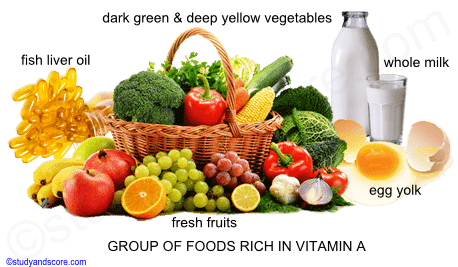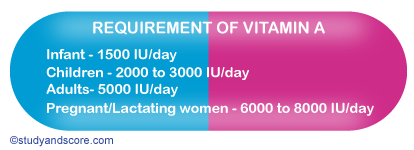Way back in 1912, Frederick Gowland Hopkins discovered that some mysterious elements in milk were essential for growth in rats. He was clear that these factors were not fats or proteins or carbohydrates. Again in 1914, these elements were re-discovered by Elmer McCollum and his group in cod liver oil. Later in 1920 these elements were termed as Vitamin A. Hopkins was awarded the Nobel prize for discovering these substances in 1929.
Vitamin A is found only in foods of animal origin. It is present in almost all species of fish, birds and mammals. The carotenoid compounds like yellow plant pigments (α, β and γ carotenes) and cryptoxanthin are precursors of vitamin A. Human body has the ability to convert these carotenoid compounds present in the diet into vitamin A.
The β-carotene gets oxidized to form two molecules of vitamin A. The other precursors like α and γ form only one molecule of vitamin A. There are two forms of vitamin A:
Vitamin A which contains alcoholic group in the side chain is called as retinol & vitamin A which contains aldehyde group is known as retinal. Though the two vitamins differ slightly in their chemical structures their physiological functions are the same.
The liver of animals is a rich source of vitamin A especially fish liver oil is an excellent source of vitamin A. Whole milk, egg yolk, dark green leafy vegetables, deep yellow vegetables and fruits are rich in carotenes, which are converted into vitamin A by the small intestinal wall.

Vitamin A is required to maintain normal blood level. The daily requirement of Vitamin A is as follows:

Vitamin A and carotene are absorbed from the small intestine into the lymph system. The rate of absorption of vitamin A is more rapid than that of carotene. In the human beings about 95% of vitamin A is stored in the liver and small amounts are also stored in lungs, adipose tissue and kidneys.
The first sign of deficiency is shown as an issue with vision. The eyes loose their green light sensitivity, later eyes cannot adjust to dim light. This condition finally results in night blindness. Severe deficiency of vitamin A is shown up as ulcers in cornea a condition also known as xerophthalmia or keratomalacia.
The following are the functions of vitamin A,

1. Mention the sources of Vitamin A.
2. How can the deficiency of Vitamin A affect human body?
3. List out the functions of Vitamin A.
- Share with your friends! -
Login to post your comment here...
- or with social Account -